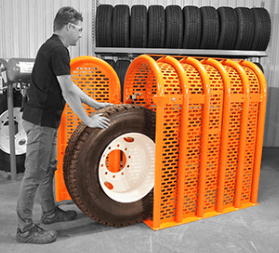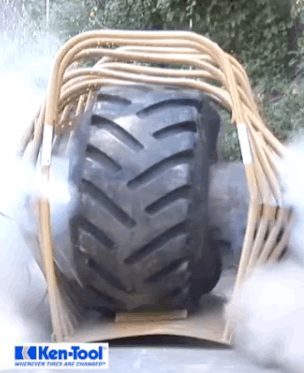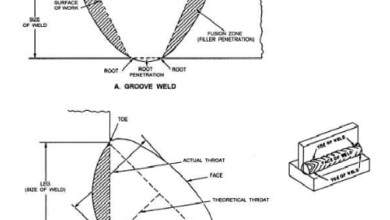Tire Cage for Occupational Safety – All Information You Need
In different kinds of worksites, we need to create the required safety applications and safety measurements. One of these safety measurements is the tire cage systems. Here we will talk about these applications. You can find detailed information about them, how to use them, what are the responsibilities and how to select a proper one.
What is Tire Cage?

A tire cage is a cage that is created with high-strength steel tubes on a plate. While workers and operators are inflating tires, they put these tires inside these cages. In the case of an explosion, the tire cage prevents any injuries that can take place. So, they are very important systems in terms of safety.
The inflation of tires takes place at very high pressures. Typical passenger car tires are generally at 30 psi pressure. When this tire explodes, probably there will not any injuries. But if we think about the big tires ır tractors, trucks, and trailers, the pressures can be up to 100 psi or more. And in the case of an explosion, there will be a very big danger for the workers. The parts of the tire can be projectiles in the case of an explosion that can hurt and even kill the people around it.
So, we use these applications to inflate big tires like this. We put the tire inside them and inflate it inside them. In the case of an explosion, they prevent these projectiles.
How to Use Tire Cage?

According to occupational safety and health standards, there are different kinds of rules when we are using tire cage applications. We need to consider them while we are working with these systems.
- The first rule is, do not alter the place of them while you are using this. Because it was probably placed according to the OSHA guidelines.
- While you are inflating the tire inside the cage, do not make any kinds of adjustments on it with a hammer or other stuff. It is very dangerous.
- The cage must be freestanding if we compare it with the other object. So, you need to place it a minimum of 3 feet away from the other objects.
- And also while you are working with the tire cage, you must be away a minimum of 10 feet from the cage.
- Do not rest the cage on different objects or devices.
- While you are applying inflation on the tire, do not allow your body parts inside the cage.
- While you are inflating the tires, always wear safety glasses and gloves.
These are the general rules that you need to comply with.
How to Select a Tire Cage?
If you need to select a tire cage application for yourself, you need to apply it accordingly. So, you need to know the general parameters that you need to consider about these systems.
- First of all, you need to know the general standards and OSHA requirements for these applications.
- The cage must meet the OSHA 29 CFR 1910.177 standard. Check this standard and be sure that the cage structure meets that standard.
- While you are looking for them, be sure that the manufacturer is reputable and known by the other installations.
- You need to know the maximum inflation pressure that you are applying. For example, if the maximum pressure is 150 psi, you need to choose an application that can withstand this pressure.
- The size of the cage is very important. You need to know the maximum size of the tire that you are inflating and choose a tire cage application according to it.
Should We Bolt Down the Tire Cages on the Ground?
This is a very common question people are ask about tire cage applications. The experts say that you should not bolt down the cage to the ground. Because you will probably use different fasteners that will not withstand very high pressures take place because of the explosion. So, these fasteners will eject in the case of an explosion and may cause very big accidents.
Liability Situations
In terms of occupational safety regulations, all the people working in that company and the company itself have liabilities.
The liabilities of the company:
- The company must provide all the necessary equipment to the workers and operators.
- They must provide a sufficient size and strength of tire cage for tire inflation.
- They must provide a suitable length of inflation hose so that people stay away from the cage while they are inflating the tire.
- They must provide high-quality safety glasses that meet OSHA standards.
- They must do the installation of the tire cage according to the standards.
- They must make periodic maintenance of the safety equipment.
- They must give important instructions and education about using this equipment and the general usage regulations to the workers and operators.
- They must control if the workers and operators are complying with these standards.
Liabilities of workers:
- The workers must comply with all the rules specified by the regulations and teach them in education.
- They must use all the necessary safety equipment while they are working.
Also, we need to know that the manufacturers of the safety equipment have liabilities. The equipment is tested and approved by different kinds of authorities. And manufacturers state that the complaints of the equipment on different standardizations.
Last Words
As you can see above, the tire cage applications may seem very basic systems to you. But they are very important systems that you need to consider different kinds of points about them. And they are very important in terms of occupational health and safety.
If you have additional comments, experiences, and questions about these systems, please valve them below. Your precious feedbacks are very important to us and our readers.
FAQs
We use them to place the big truck and trailer tires inside it and inflate tires inside this cage. In the case of any explosion, the cage prevents projectiles that can harm the people around the cage.
Occupational safety experts state that we should not bolt them down to the ground. Because the bolts and fasteners can act as projectiles in the case of an explosion.
In general, we use these applications for big tires and very high pressures such as 75-100 psi. So, if you are driving a passenger car, you probably do not need a tire cage application.



